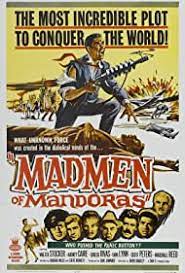
Professor John Coleman (John Holland) has developed an antidote for a deadly nerve gas. The professor is the only one who can create the antidote. Professor Coleman’s youngest daughter, Suzanne (Dani Lynn) is kidnapped. Shortly after that the Professor himself is taken at gunpoint by two hoods.
Professor Coleman’s other daughter, Kathy Coleman “KC” Day (Audrey Caire) is married to Phil Day (Walter Stocker). Phil works for a government security agency. On their way to an event, they are approached by a guy named Teo Padua (Carlos Rivas) who tells them that KC’s father has been taken to Mandoras. Before he can tell them much more he is shot and killed. Phil and KC decide they need to go to Mandoras to find Professor Coleman.
In Mandoras they are met by the chief of police, Alaniz (Nestor Paiva). Alaniz takes them to their hotel and gets them checked in. They are followed by some goons. In their hotel room they meet a man who says he is Teo’s brother Camino Padua (Carlos Rivas). Camino tells them a wild story.
He says that at the end of WWII a group of German doctors, to save the Reich, performed an operation on Hitler and removed his head. The head has been kept alive by artificial means and rules a Nazi faction that has overrun Mandoras. The Nazis plan on releasing the deadly nerve gas. With no antidote to the poison, they will be able to step in and conquer the world.
“The Madmen of Mandoras” was released in 1963 and was directed by David Bradley. It is a low budget American science fiction thriller and a strange bit of Nazisploitation.
It’s not really a good movie, but it is so much better than the hodge-podge that was released years later as “They Saved Hitler’s Brain”. Unfortunately, “They Saved Hitler’s Brain” gets a lot more attention and screen time than the original movie. The original film had potential, but it still had that stupid head in a jar. There is also a longer head sequence at the end of “Madmen” that was cut out of “Hitler’s Brain”.
The movie tries to be deep and the scene where Camino is explaining the Nazi plot is actually done quite well. Another interesting sequence is the noirish scene where Phil and KC are being stalked in the makeshift back alleys of Mandoras by a Nazi killer. A lot of the cinematography is simplistic but effective and the production values bare bones but used creatively. A lot of the film is actually quite artistic. It’s that whole head-in-a-jar thing that tosses the movie squarely into the realm of camp. It’s an interesting movie visually but the slow spots trip it up.
Some of the movie was filmed at Bronson Caverns and the rest on back lots.

